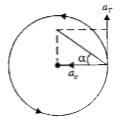A cylclist is riding with a speed of . As he approaches a circular turn on the road of radius , he applies brakes and reduces his speed at the constant rate of . What is the magnitude and direction of the net acceleration of the cyclist on the circular turn ?
This is a case of a body moving in a circular path with variable speed. So it has centripetal acceleration and tangential which are perpendicular to each other. The resultant acceleration.

Tangential acceleration
Let the resultant acceleration make an angle a with the radius. Then
.
Topper's Solved these Questions
- CIRCULAR MOTION BOOK - ICSECHAPTER - CIRCULAR MOTION EXERCISE - MODULE 1 (CONCEPTUAL SHORT ANSWERS QUESTIONS WITH ANSWERS )
11 Videos
- CIRCULAR MOTION BOOK - ICSECHAPTER - CIRCULAR MOTION EXERCISE - MODULE 1 (LONG ANSWER QUESTIONS)
8 Videos
- COMPETITION CARE UNITBOOK - ICSECHAPTER - COMPETITION CARE UNITEXERCISE - OBJECTIVE QUESTIONS FROM PREVIOUS IAS EXAMINATIONS
50 Videos
Similar Questions
A cyclist is riding with a speed of 27kmh−1. As he approaches a circular turn on the road of radius 80 m, he applies brakes and reduces his speed at the constant rate 0.5ms−1. What is the magnitude and direction of the net acceleration of the cyclist on the circular turn ?
View SolutionA catlyst is riding with a speed of 27 km/h. As he approaches a circular turn on the raod of radius 80m, he applies brakeks and reduces his speed at the constant rate of 0.50m/s every second. What is the magnitude and direction of the net acceleration of the cyclist on the circular turn?
View Solution
Knowledge Check
A cyclist is riding with a speed of 27kmh−1. As he approaches a circular turn on the road of radius 80 m, he applies brakes and reduces his speed at the constant rate 0.5ms−2. What is the magnitude and direction of the net acceleration of the cyclist on the circular turn ?
A0.68 m s−2B0.86 m s−2C0.56 m s−2D0.76 m s−2If a cyclist moving with a speed of 4.9 m/s on a level can take a sharp circular turn of radius 4 m, then coefficient between the cycle tyres and road is
A0.41B0.51C0.61D0.71A particle is moving on a circular path of 10 m radius. At any instant of time, its speed is 5ms−1 and the speed is increasing at a rate of 2ms−2. At this instant, the magnitude of the net acceleration will be
A5ms−2B2ms−2C3.2ms−2D4.3ms−2
A satellite is launched into a circular orbit of radius R around the earth while a second satellite is launched into an orbit of radius 1.02R. The percentage difference in the time period is:
View SolutionA cyclist riding at a speed, of 24.25ms−1 takes a round a circular road of radius 34.64 m. What is his inclination to the vertical ?
View SolutionA car is travelling at 20 m/s on a circular road of radius 100 m. It is increasing its speed at the rate of 3 m/s2. Its acceleration is
View SolutionA motor car travelling at 30m/s on a circular road of radius 500m. It is increasing its speed at the rate of 2ms−2. What its accleration at that instant ?
View SolutionAn athelete takes 2.0 s to reach his maximum speed of 18.0 km/h. What is the magnitude of his average acceleration?
View Solution
